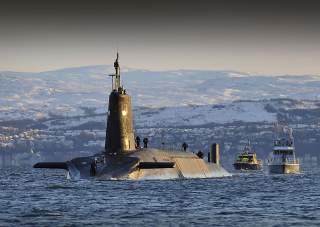Does America's Most Deadly Nuclear Missile Have a Big Problem?
The D5 is one of Washington's most feared weapons that it shares with London. But a recent test could show a possible problem...or not.
What caused a British-operated Trident II D5 submarine-launched ballistic missile (SLBM) to go off course?
British media reports that a Trident II SLBM launched from HMS Vengeance—a Vanguard-class boomer—went drastically off target this past June. According to those reports, the submarine launched the test missile against a target on the west coast of Africa, however the missile veered toward the continental United States. If the failure is the result of a technical problem with the missile—there could be serious implications for the United States’ own strategic nuclear deterrence, which relies on the Trident II D5 as a key part of its nuclear triad. But that assumes that there is a systemic problem with the weapons.
The United States Navy has not suffered a Trident II failure in recent memory, but there is a small possibility that this British failure could be indicative of defect in the missile. “One failure isn't enough to conclude we are in the tail end, statistically speaking,” Jeffrey Lewis, Director of the East Asia Nonproliferation Program at the James Martin Center for Nonproliferation Studies at the Middlebury Institute of International Studies at Monterey told me. “Now, you do need to figure out what went wrong. It is possible that it was an age-related defect, or a modification to the missile—which we make all the time—something with the test payload (it was unarmed) or something with the submarine. Maybe the failure reveals a show-stopper of a problem, although the excellent record of the D5 suggests it will be something small.”
However, overall, the Trident II has a remarkable reliability record. “There have been only a few failures—the Royal Navy one in June and perhaps one more a few years ago,” Lewis said. “Even at two out of 163, the D5 is remarkably reliable. There were some additional failures early in the program, but that's a typical bathtub effect where you get failures at the beginning while you develop the missiles, then failures at the end when it ages out.”
But if there is a systematic problem with the missiles, the U.S. Navy is also impacted.
“The UK leases its D5 missiles out of a common pool shared with the U.S.,” Lewis told me. “They are the same missiles as the U.S. uses. While the U.K. has conducted relatively few firings—this was the first since 2012—the U.S. has conducted 161 successful firings since 1989.”
For the British government, covering up the test failure was likely a stupid public relations move. “Obviously, the Tories, mindful of the vote on Dreadnaught [replacement for the Vanguard-class], covered it up to the avoid the embarrassment. This is a serious mistake in my view. One former Admiral called it ‘bizarre and stupid.’ I think he's altogether too kind,” Lewis said. “The cover-up gives the impression that the system has major flaws that are being hidden. I doubt it, but how can [British Prime Minister Theresa] May offer her word as bond on that point?”
The entire fiasco is has a negative impact on nuclear deterrence and on the political support for the British Trident program. “That's bad for deterrence, as well as the political support for the massive investment that Dreadnaught will require,” Lewis said. “It is also unethical, I am old-fashioned that way.”
Meanwhile, the United States Navy—the by far the largest Trident operator and steward of the bulk of America’s nuclear forces—did not comment by press time.
Dave Majumdar is the defense editor for The National Interest. You can follow him on Twitter: @davemajumdar.
Image Credit: Creative Commons.

